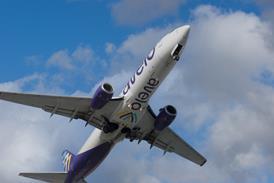Helen Massy-Beresford meets the men behind the deal.
US-based manufacturer Esterline prides itself on its diversified customer base. “It’s really hard to find a military programme we’re not on,” says CEO Bob Cremin.
Esterline also counts most of the major civil aircraft manufacturers among its customer base, but it is only recently that its name has become better known in the industry, with its $335 million purchase earlier this year of Canada’s CMC Electronics.
With the acquisition, Esterline is accelerating its drive to become a systems integrator, and has increased its presence as a Tier 1 manufacturer. “The attraction of CMC was the ability to do software to make components smart – we didn’t have the ability as an integrator before,” Cremin says.
Now, with its avionics and control division given a major boost with the arrival of CMC, Esterline will be aggressively targeting the electronic flight bag market, targeting the military market for the first time, as well as taking on complete helicopter cockpit upgrades. “We see a very large need for retrofit helicopters around the world – we have a good amount of content. CMC brings the ability to integrate and do the whole cockpit.”
CMC, which posted revenues of C$205 million ($193 million) in 2006, also significantly boosts Esterline’s revenues – $972 million in 2006. Individual CMC products were attractive for its new owner – for example the Montreal-based company’s presence on the Raytheon T6-B military trainer was a draw, Cremin says. “Aside from the products, some accounts are very strong and we can ride on their coat tails.”
It is still early days for the deal, which was completed in March, but Cremin says he is “thrilled” with the outcome, while CMC chief executive Jean-Pierre Mortreux says its new ownership by a long-term player specialising in aerospace and defence is already paying dividends.
Esterline is the latest in a series of owners for the Canadian electronics specialist, which started life as Canadian Marconi and has been owned by BAE Systems and most recently private equity investor Onex.
Short-term
“Being part of a group that knows the cycle and the business is better for the company and better for the customer, he says. Onex was “a very good partner, not short-term orientated,” Mortreux says, “but we sometimes missed out on opportunities with customers who said that they were unsure of the long-term strategy of the owner.”
Things have changed already: “We immediately felt the benefit when discussing with prospective customers. Major US clients have made clear that the good relationship they have with Esterline’s other divisions is a plus for us.”
CMC also benefits from its new owner’s global presence: “We’re a global supplier that happens to be based in the USA. Half of our employees and revenues are overseas,” says Cremin. Mortreux agrees that “Esterline has opened doors in China.”
Aside from the immediate benefits for both parties’ strategy and portfolio, the deal fits in neatly with wider aerospace trends. “Customers are saying that we need to be concerned with the electronic/mechanical interface – we’re checking every box with the two together. There is a very strong trend at OEM level towards not wanting to build as many things as in the past,” Cremin says. As Airbus follows Boeing’s lead this capability can only become more important.
Bonus
And in an industry facing a serious engineering skills shortage, the acquisition of 400 employees with technical degrees along with the CMC business is a major bonus. “They are based in an aero-centric area – this is critically important for our growth,” Cremin says.
In the longer-term, CMC will be a key weapon in Esterline’s arsenal as it faces up to challenges like the next generation single-aisle aircraft – research for potential offerings has already begun – and the need for greener, more efficient aircraft.
“We see a unique opportunity for CMC and Esterline in green aircraft. Thirty to forty years ago the name of the game was speed at all costs. Now if we want to be part of the picture we have to focus on lowering costs,” says Mortreux. CMC’s flight management technology has already led to a 2-3% cut in fuel consumption, and Mortreux says the company is aiming for 5% within 3-4 years as it continues to increase the accuracy of the systems.
“We define how the future will look together. We follow trends, strategies, technologies – but at the end of the day we have to let them run their own business. I see us as engineers who like to invest in a good business. CMC is a good business,” says Cremin.
Source: Flight Daily News























